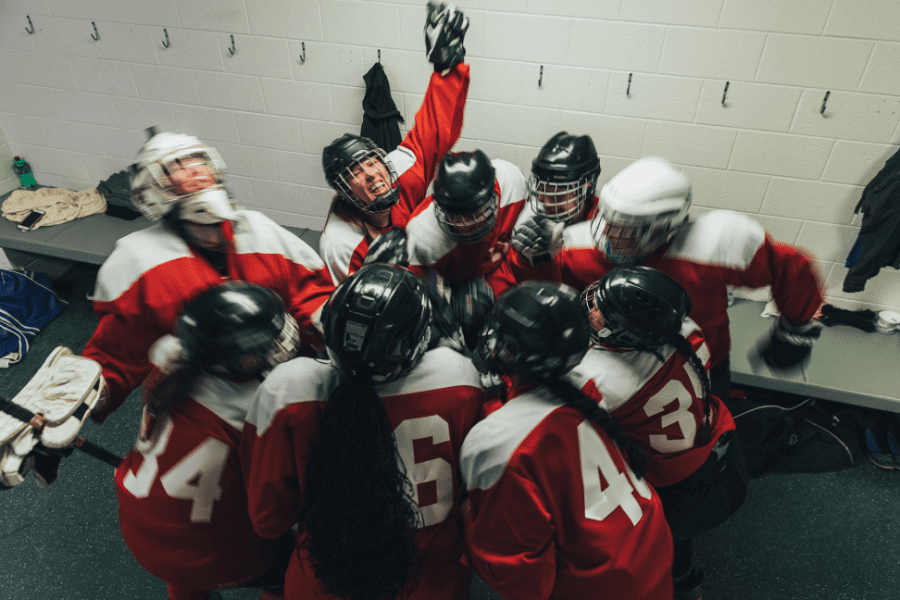Can Hockey End in a Tie? The Puck Stops Here – Answering Your Questions
Can hockey end in a tie? The answer might surprise you! In the world of ice hockey, the rules around game endings have evolved, bringing a mix of suspense and strategy to every match. While ties were once a common occurrence, modern rules have introduced new twists to keep fans on the edge of their seats.
Dive into the icy depths of hockey regulations with us as we explore how overtime and shootouts have changed the face of the game.
A bewildering question echoes through the stands – can hockey end in a tie? Whether we’re talking about regular season games or the hair-raising tension of the NHL playoffs, the concept of a tied hockey match can split fans faster than a slap shot.
Let’s slice through the surrounding fate of a draw in a hockey game. Sure, the term ‘tie’ seems gentler than a goalie’s glove save, but in the realm of the National Hockey League, does the siren allow for a harmonious ceasefire?
Stick with me as I deke out the doubts and aim for the top shelf of your curiosity.
After all, getting to the bottom of this is more satisfying than a breakaway goal.

Key Takeaways
- The possibility of a hockey game end without determining a winner is a hot debate topic among fans of the sport.
- Understanding the nuances of tied matches is critical for those following the National Hockey League.
- Historical context is pivotal when discussing whether there can be no winner in a hockey game.
- Hockey rules have evolved, particularly regarding how a winner is determined in both regular season games and the NHL playoffs.
- The National Hockey League has crafted a spectacle that aims to decisively crown a victor, leaving draws in the dust.
Exploring the Evolution of Hockey Game Endings
Oh, how the times have slapped the puck into a new net of rules! Cast your mind back, way back, to the so-called dead puck era—a frosty part of NHL history when tie games in hockey would end with sticks aloft and chins held high, no strings attached. But as we all know, the winds (and skates) of change have a habit of turning tides and transforming the once-still waters of professional hockey leagues into a wave pool of rule changes.

The Journey from Dead Puck Era to Modern Regulations
Hockey game endings have evolved significantly over time. During the dead puck era, NHL games could end in a tie, leaving teams with equal points. However, seeking to heighten excitement and ensure a decisive outcome for each game, the NHL made pivotal changes post-2004 lockout.
The league introduced the shootout rule for regular season games that remained tied after a five-minute, sudden-death overtime, initially played with four skaters aside, now three. This shift aimed to eliminate ties, creating a clear winner for every game. The introduction of the shootout, along with a revised points system—two points for a win, one point for an overtime or shootout loss, and zero for a loss in regulation—added a new layer of strategy and excitement to the sport.
Overtime Rules in Hockey: From Sudden Death to Shootouts
Let’s waltz over to the overtime rules in hockey for a second.
The first overtime period in the NHL’s yesteryears was all about the sudden death approach—fast, furious, and unforgiving. But the NHL, much like my reliance on sports metaphors, wasn’t content to rest there.
Enter the five-minute sudden-death overtime period, a spectacle of speed that often still ended in a tie.
And then the titular game-changer: the shootout in hockey—a penalty shootout where wily forwards stare down stoic goaltenders, and the only tie you’ll see is in the laces of the skates.
How the NHL’s Approach to Ties Has Changed Over Time
- Once a noble end to a closely fought match, tie games were a testament to evenly matched teams in regular-season games and playoff games alike. But the NHL, my friends, decided ties were just the sartorial choices of broadcasters—not for games. The rule change beckoned a new era: no more ties, no more “good game, see you next time,” but rather a clear victor each night.
- With the adoption of the shootout rule in the 2005-06 season, the NHL tossed tie games out like an old pair of skates. Suddenly, determining a winner in hockey became as essential as a cold drink after a tight game. The result? A shift from a culture of acceptance of tie games to a crescendo of conclusive bouts, demonstrating that in the stakes of entertainment, the NHL had decided overtime wasn’t enough—it wanted a shootout spectacle.
So, my fellow ice aficionados, the puck doesn’t lie.
The evolution of tie games in hockey from the dead puck era to our present-day rink rush is nothing short of remarkable.
Whether it’s the adrenaline burst from a five-minute sudden-death overtime period or the gasp-inducing drama of penalty shots, it’s clear: the NHL’s rulebook is always one stride ahead, ensuring each NHL game ends with a crescendo.
And while some may pine for the quiet dignity of a game’s tie, I say, bring on the spectacle—I’ve got my popcorn ready.
Can Hockey End in a Tie?
Let’s glide over the slick ice of NHL hockey games and dissect the endgame scenarios where the scoreboard teases a deadlock.
In the regular season of the NHL, games bristle with competitive fervor, paralleled only by the intensity of the Stanley Cup Playoffs.
Let’s take a peek at what happens when the cacophony of the final horn resonates at the end of the game, and teams are shackled in an equally yoked tug-of-war.
Imagine we’re there, right in the gutsy climax of the third period, scores tied, hearts pounding, and the NHL level of hockey rearing up to its full, towering stature.
What’s next? The alarm sounds, gates open, and we’re nudging into an overtime period. A rapid, five-minute, 3-on-3 skirmish unfurls, an attempt to crown a victor.
Still tied? There’s an encore, folks – the looming showdown of a penalty shootout.
Tie games in hockey – at least at the professional tableau of the NHL – have been nudged into shadowy lore.
Yet, in the rare case that our champions in skates end the regular 60-minutes of play in a draw, the league tosses them into a post-regulation gladiator ring to declare an indisputable winner.

The very acronym of NHL might as well stand for ‘No Half-measures League.’
| Rule Evolution | Regular Season | Stanley Cup Playoffs |
|---|---|---|
| Overtime Period | 5-minute 3-on-3 | Continuous OT Periods |
| Game Remaining Tied | Shootout Ensues | Plays Until a Goal |
| Outcome | No Tie Possible | No Tie Possible |
So, the era of tie games in hockey at the NHL level, much like the dinosaurs, has been made extinct.
A toast to the thrill of certainty in an uncertain world!
Conclusion
In the final buzzer-beating moments of this journey through the NHL’s rulebook, it’s clear that hockey’s tie-breaking procedures serve up a fascinating dichotomy.
As we’ve toured the gamut of overtime rules, from the strategic chess match of 3-on-3 overtime to the win-or-lose spectacle of shootout rule, the verdict seems to be that the current system delivers a decided blend of innovation and eyebrow-raising controversy.
Understanding the Pros and Cons of the NHL’s Current System
Debating the merits of the NHL’s approach to no winner in a hockey game leaves us in a rink divided.
The league’s rule changes have been both lauded and lamented; advocates argue that the frenzy of NHL games ending with clear victors fuels excitement, while traditionalists might view such moments as a departure from the ethos of the sport.
Yet, one cannot ignore the palpable electricity in the air when overtime winds down, and the potential for triumph or defeat falls to end of overtime heroics or the suspense of a penalty shootout.
It’s a spectacle engineered for an era that craves decisive outcomes and abhors the ambiguity of tie games in hockey.
Will We Ever See the Return of Tie Games in Professional Hockey?
Imagine an NHL where the scoreboard reflects a horizontal line of solidarity, as tie games make a storied comeback.
Might the rulebook one day flip backwards, reintroducing the concept of tie games in professional hockey leagues?
It’s a distant thought, perhaps, but hockey, like all enduring sagas, is ripe with nostalgia and the potential for revival.
While today the NHL leans heavily on rules ensuring a team must always emerge triumphant, I can’t help but ponder if there will come a day when fans and players alike just might see the charm in games that end locked in an indomitable stalemate.
FAQ
Can hockey end in a tie?
Grab your skates, folks! In the modern era of professional hockey, particularly in the NHL, games skate to a definite close with nary a tie in sight. Think of a tie as that ex who just won’t show up anymore.
Regular season matches blaze into overtime, and if the deadlock holds, bam!
The shootout drops the final puck.
During the Stanley Cup playoffs, teams grapple in continuous overtime until a hero emerges.
So, to cut to the chase, ties are as out-of-style as mullets in hockey.
What happens when a hockey game is tied at the end of regulation in the regular season?

When the buzzer blares and the scoreboard winks at both teams with the same number, the NHL cranks up the drama with a five-minute, 3-on-3 overtime period. Think of it as mini hockey on turbo-charge!
It’s sudden death, folks: first goal wins.
If this breakneck extra time doesn’t crown a winner, we roll out the red carpet for the shootout stars, as they take turns flirting with the opposing goaltender to break the tie.
How does a shootout work in hockey?
Ah, the shootout – hockey’s version of a high-noon duel.
After overtime does its dance without a victor, each team selects a handful of sharpshooters who take the spotlight for one-on-one battles with the goalie. It’s a veritable tango on ice: player versus goaltender, hopes versus nerves.
Each player gets one shot, unless we’re neck and neck after the initial rounds; then it’s a dramatic back-and-forth until one team outshines the other.
Are tie games possible in playoff hockey?
As likely as spotting a unicorn on the ice, my friends! Playoff games in the NHL ditch the shootout and opt for the glory of continuous overtime instead.
Teams play full 20-minute periods until someone scripts a fairy-tale ending with a game-winning goal. It’s the ultimate endurance test and as ties are a no-show, expect heart-pumping, edge-of-your-seat action until the victory is sealed.
Why did the NHL get rid of tie games?
Picture this: It’s the early 2000s, and the NHL is eager to inject more excitement into the game.
The league waved goodbye to the tie and welcomed the shootout rule in the 2005-06 season, guaranteeing that each contest ends with a winner basking in high-fives and a loser left to sigh.
It was a move that gave us more decisive outcomes and a bushel of buzzy watercooler moments.
What led to the introduction of the 3-on-3 overtime format?
Think of it as hockey putting on a speed suit.
The old 4-on-4 format was zippy, sure, but the NHL craved even more open ice and gasp-inducing breakaways.
In 2015, the league dialed it up to “ludicrous speed” by bringing in the 3-on-3 overtime format during regular season games.
The result? More space, more chances, and a better shot at a walk-off goal before reaching the shootout. It’s like a double shot of espresso for the game – pure, uncut adrenaline!



